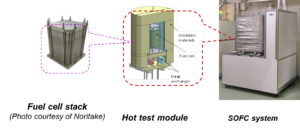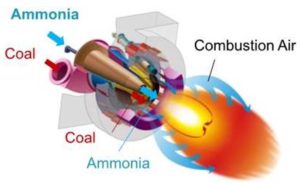A Deep Dive into SIP “Energy Carriers” Ammonia Combustion Research (second half)
By Bunro Shiozawa on October 13, 2020
Editor’s note: Bunro Shiozawa is a Senior Associate at Sumitomo Chemical Company. He has played a unique role in building the case for ammonia as a hydrogen carrier, serving from 2014 to 2018 as Deputy Program Director of Japan’s SIP “Energy Carriers” initiative. Over the last year he published in the on-line journal of the International Environment and Economy Institute a ten-part series of articles that describe and reflect on the work done by him and his colleagues, and its impacts in Japan and beyond. Shiozawa’s English translation of the first half of Part 4 of the series was posted on September 23, 2020. The second half follows.
Ammonia co-firing in a pulverized coal-fired boiler
It was thought that one of the promising applications of NH3 as a fuel would be to co-fire it with coal at coal-fired power plants. The slow burning speed of NH3 was thought to be suitable for co-firing with pulverized coal, and co-firing NH3 would reduce CO2 emissions from coal-fired power generation in proportion to the amount of co-fired NH3. But there was a big concern with co-firing in this way: emission of a large amount NOX from the combustion process.
In the SIP “Energy Carriers”initiative, the combustion behavior of pulverized coal and NH3 during co-firing was studied in detail by a team at Osaka University [1]. while co-firing tests with an NH3 ratio of 20% were conducted by the Central Research Institute of Electric Power Industry (CRIEPI) using both single and multi-burner furnaces. The results of these tests showed that by adjusting the injection point and feed rate of NH3 into the furnaces, NOX emission could be contained and controlled [2], and no N2O which might be formed in the combustion process was detected in the exhaustion gas.
Based on these basic study results, the Chugoku Electric Power Co., Ltd. conducted a demonstration test of coal-NH3 co-firing at its commercial power plant, Mizushima Thermal Power Station Unit 2 (156 MW rated output). The demonstration test confirmed that CO2 emissions were reduced by the amount of NH3 co-firing; the NH3 used as fuel was completely burnt and not emitted outside the plant; NOX emissions were not significantly different from those of 100% coal-fired power plants; and the plant met environmental standards without any problems [3][4]. Although the ratio of NH3 was only 0.6 to 0.8% due to the limited capacity of the existing NH3 vaporizer, the most significant achievement was the confirmation that the coal-NH3 co-firing technology can be applied to power plants in commercial operation without any problems as a CO2 emissions reduction measure.
Based on the results of this demonstration test, the Chugoku Electric Power Co., Ltd. has evaluated the coal-NH3 co-firing technology as “a low-cost CO2 reduction technology which does not require a large remodeling of coal fired power generation facility including denitration equipment, and therefore maximizes the use of existing coal-fired power generation facilities.” [5]
Following this demonstration, IHI Corporation developed a coal-NH3 co-firing burner that can be attached to an existing coal-fired boiler in a way that minimizes incremental NOX emissions. After installing its coal-NH3 co-firing burner, IHI analyzed changes in the boiler’s heat collection characteristics when NH3 is mixed into the fuel. It was confirmed that at 20% NH3 co-firing, CO2 emissions decreased 20%; NOX emissions could be reduced to the level of 100% coal combustion; and the heat collection performance of the boiler did not change significantly. This study was conducted because there was a concern that the heat distribution on the furnace wall of a boiler may change, as the flame temperature of NH3 is generally lower than that of coal, and co-firing with NH3 reduces the amount of soot and coal powder particles in the furnace which produce radiative heat [6].
The coal-NH3 co-firing technology for coal-fired power generation boilers does not require major equipment modification. As a result, the technology is attracting a great deal of attention from the power industry as a means of reducing CO2 emissions from existing coal-fired power plants which have no economic CO2 emission reduction options other than the introduction of biofuels.
For commercial implementation of this technology, the New Energy and Industrial Technology Development Organization (NEDO) is planning to provide support for a long-term technical demonstration at an actual coal-fired power plant. Companies involved in this implementation plan are currently working on detailed design and feasibility analysis for the demonstration.
Industrial furnaces
Japan’s industrial sector accounts for more than 20% of the country’s fossil fuel consumption. Research supported by the SIP “Energy Carriers” found that NH3 could also be used as a fuel for industrial furnaces even though such furnaces come in various sizes and types.
One of the challenges of using NH3 as a fuel in industrial furnaces is reduced radiative heat transfer from the flame since NH3 in combustion does not have the radiative heat transfer effect generated by soot combustion when carbon-based fuels are used. In the course of a study conducted at Osaka University, it was found that enhanced flame radiation from oxygen-enriched combustion and multi-stage combustion to achieve flame temperature uniformity could overcome these problems in both 100% NH3 combustion and CH4-NH3 mixed combustion (co-firing ratio: 30%) in a 10 kW class model furnace. In addition, the same results were confirmed by a demonstration study using a 100 kW class model furnace, which is close to the practical scale of industrial furnaces used by industry [7].
In a project supported by the SIP “Energy Carriers” initiative, this technology was actually applied to a degreasing furnace used in the pretreatment process for hot-dip galvanized steel sheet production. Taiyo Nippon Sanso Co., Ltd. and Nippon Steel Nisshin Co., Ltd. conducted a verification test to confirm applicability of this technology at one of the latter’s production lines. By mixing conventional CH4 fuel with NH3 (co-firing ratio: 30%) to heat the furnace, they confirmed that such co-firing could be applied to this process and reduce CO2 emission by 30% [8].
NH3 fuel cell
Direct use of NH3 in forms other than combustion has also yielded important results, specifically in the use of NH3 as a fuel for fuel cells.
Solid oxide fuel cells (SOFCs) operate at temperatures of 700-1,000°C. NH3 decomposes into hydrogen and nitrogen (N2) at temperatures above 500°C. Therefore, it was thought that NH3 itself could be used as a fuel for SOFCs. Thus, the idea was to supply NH3 instead of hydrogen as a fuel for SOFCs in order to avoid the difficulties of transporting and storing hydrogen in large amounts.
At present in Japan, SOFCs are supplied with city gas and LP gas. These commodities are inexpensive and easy to transport and store. In order to obtain hydrogen from these gases to fuel SOFCs, it is necessary to integrate a gas reformer within the SOFC’s balance of plant. The reformer emits CO2 during the reforming process. One way to solve these problems is with a pure hydrogen supply system. However, if hydrogen can be produced from NH3, the hydrogen transportation and storage problems can be avoided. And, of course, no reformer is needed. Thus, if NH3 can be used directly as a fuel for SOFCs, it will greatly improve the convenience of SOFCs. Since SOFCs are expected to play an important role as a distributed CO2-free power source in coming years, the SIP “Energy Carriers” initiative explored the option of NH3 direct-use technology as a fuel for SOFCs.

In the course of this research and development, a research team at Kyoto University confirmed that NH3 could be used as a fuel for SOFCs and that the power generation performance of NH3-fueled SOFCs was equivalent to that of pure hydrogen (53% efficiency (LHV) at 255W of direct current power generation) [9]. Based on these results, Noritake Company, Ltd. fabricated a 1kW-class stack, and IHI Corporation developed a 1kW NH3-fueled SOFC system [10]. IHI Corporation is continuing development of a larger commercial-use NH3-fueled SOFC system.
Significance of the results of the development of NH3 direct utilization technology
The International Energy Agency (IEA) has recognized the significance of these achievements in the development of NH3 direct utilization technologies in its “The Future of Hydrogen” report:
- Coal-NH3 co-firing technology in coal-fired boilers will be an important means to reduce CO2 emissions from existing coal-fired power plants;
- Direct use of NH3 in gas turbine power generation will be an important means of reducing CO2 emission of thermal power generation — which is expected to play an important role in ensuring the “adjustability” of the electricity grid once a large amount of solar and wind energy has come on line.
Although not described in detail in this article, the results of the development of these technologies for direct use of NH3 are also expected to play a major role in the de-carbonization of fields other than electric energy, namely, thermal energy, which accounts for about 70% of Japan’s final energy consumption. This will be the topic of a future article.
Postscript
Mr. Shiozawa advises readers who would like more detailed information to refer to the November 2019 edition of the Journal of the Combustion Society of Japan which features “Initiatives for Social Implementation of Ammonia Direct Combustion”. In this special issue, the researchers who actually carried out the work supported by the SIP “Energy Carriers” initiative describe their findings and achievements for each of their R&D focuses. The SIP “Energy Carriers” work also attracted the attention of the Combustion Institute, an international academic society of combustion science. The Combustion Society of Japan, the Combustion Institute’s Japanese branch, in addition to publishing the special issue, awarded its 2019 Technology Award to the SIP “Energy Carriers” initiative for supporting valuable research on NH3 combustion. Finally, the SIP “Energy Carriers” initiative produced a 10-minute English-language video that describes the initiative’s R&D achievements.
References
[1] 「層流対向流場において水素拡散火炎により保炎される微粉炭粒子とアンモニアの混焼挙動」 Junpei Fukui, Noriaki Nakatsuka, Kazuki Hatanaka, Gidetaka Higashino, Jun Hayashi, Fumiteru Akamatsu, Report No. C334 at 54th Combustion Symposium, The Combustion Society of Japan, 2016
[2] “Ammonia Co-Firing Technology Applicable to Pulverized Coal Fired Boilers,” Masayoshi Kimoto, Akira Yamamoto, Yasushi Ozawa and Saburo Hara, Vol. 61, No. 198, pp 299-303, Journal of the Combustion Society of Japan (November 2019)
[3] 「水島発電所2号機でのアンモニア燃焼試験-アンモニアの発電利用に関する事業性評価- (Demonstration Test of Ammonia-Coal Co-Firing at No.2 Plant of Mizushima Power Generation Plant) 」 谷川博昭(Hiroaki Tabigawa)、大内優(Masasu Ouchi)、pp52-55,「電気評論 (Electrical Review)」 2018年4月号(April 2018)
[4] “Test of the Co-Firing of Ammonia and Coal at Mizushima Power Station,” Tsukasa Yoshizaki, Vol. 61, No. 198, pp 309-312, Journal of the Combustion Society of Japan (November 2019)
[5] 「中国電力における技術革新の歩み (History of innovations achieved in The Chugoku Electric Power Co., Inc.)」 迫谷章 (Akira Sakoya)、「電気評論 (Electrical Review)」 pp138-152, 2018年1月号(January 2018)
[6] “Development of the Coal Co-Firing Technology with Ammonia and Numerical Evaluation of the Boiler Performance,” Takamasa Ito, Juwei Zhang, Sakiko Ishihara, Hiroki Ishii, Toshiyuki Suda and Toshiro Fujimori, Vol. 61, No. 198, pp 304-308, Journal of the Combustion Society of Japan (November 2019)
[7] “Review of Fundamental Study on Ammonia Direct Combustion in Industrial Furnaces”, Ryuichi Murai, Noriaki Nakatsuka, Hidetaka Higashino and Fumiteru Akamatsu, Vol. 61, No. 198, pp 320-325, Journal of the Combustion Society of Japan (November 2019)
[8] “Development of Impinging Jet Burner Using Ammonia Fuel for Degreasing Steel Sheets”, Masaaki Numata, Taizou Matsuda, Yoshiyuki Hagiwara and Yasuyuki Yamamoto, Vol. 61, No. 198, pp 326-330, Journal of the Combustion Society of Japan (November 2019)
[9] http://www.jst.go.jp/pr/announce/20150722-6/index.html
[10] http://www.ihi.co.jp/ihi/all_news/2018/technology/2018-5-16/index.html
